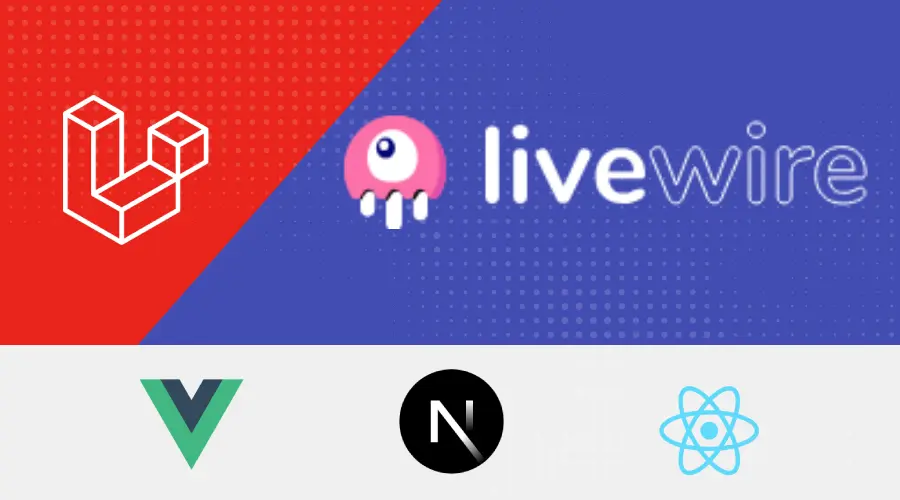What is Laravel Livewire?
Laravel Livewire is a full-stack framework for building dynamic web applications using Laravel and Alpine.js. It allows developers to create interactive interfaces using server-side rendering, without writing JavaScript code. Livewire enables developers to build rich, dynamic UIs using the familiar syntax of Laravel, including Blade templates and PHP logic.
Factors Contributing to the Rise in Laravel Livewire Adoption
The increasing popularity of Laravel Livewire can be attributed to several factors. Firstly, it simplifies the development process by allowing developers to focus on writing PHP code instead of complex JavaScript. Additionally, it provides real-time updates to the UI without the need for manual AJAX calls, enhancing the user experience. Moreover, its seamless integration with Laravel, the widely used PHP framework, makes it an attractive choice for developers already familiar with Laravel's syntax and conventions.
Comparative Advantages of Laravel Livewire Over Alternative Laravel Full-Stack Frameworks
Laravel Livewire stands out from other Laravel full-stack frameworks due to its simplicity and ease of use. Unlike traditional JavaScript-heavy frameworks like Vue.js or React, Livewire enables developers to leverage their existing PHP skills to create dynamic interfaces. Additionally, it eliminates the need to write separate API endpoints for client-server communication, resulting in faster development cycles and reduced complexity.
Vue.js vs. Laravel Livewire:
Programming Paradigm:
- Vue.js: Vue.js is a JavaScript framework that follows a reactive and component-based approach. Developers write components using Vue's template syntax and JavaScript logic.
- Laravel Livewire: Livewire, on the other hand, is a full-stack framework for Laravel that emphasizes server-side rendering and uses PHP and Blade templates for UI components.
Client-Side vs. Server-Side Rendering:
- Vue.js: Vue.js primarily operates on the client side, rendering components in the browser and handling user interactions with JavaScript.
- Laravel Livewire: Livewire performs server-side rendering, generating HTML on the server and sending it to the client. It updates the UI dynamically without requiring manual AJAX calls or client-side JavaScript.
Learning Curve:
- Vue.js: Vue.js has a moderate learning curve, especially for developers familiar with JavaScript and front-end development concepts.
- Laravel Livewire: Livewire's learning curve is lower for developers already proficient in PHP and Laravel, as it allows them to leverage their existing skills without diving deep into JavaScript.
//Example Of Vue.js Component
<template>
<div> <p>{{ message }}</p>
<button @click="increment">Increment</button>
</div>
</template>
<script>
export default {
data() {
return {
message: 'Hello Vue.js',
count: 0
};
},
methods: {
increment() {
this.count++;
}
}
};
</script>React.js vs. Laravel Livewire:
- Component-Based Architecture:
- React.js: React.js is a JavaScript library for building user interfaces with a component-based architecture. Developers write JSX, a syntax extension for JavaScript, to define components and their behavior.
- Laravel Livewire: Livewire follows a component-based architecture but uses PHP and Blade templates instead of JSX to define components and logic.
- Virtual DOM vs. Server-Side Rendering:
- React.js: React.js utilizes a virtual DOM to efficiently update the UI by minimizing DOM manipulation. It works primarily on the client side, rendering components in the browser.
- Laravel Livewire: Livewire performs server-side rendering, generating HTML on the server and sending it to the client. It updates the UI dynamically without relying on a virtual DOM.
- Tooling and Ecosystem:
- React.js: React.js has a robust ecosystem with a wide range of third-party libraries, tools, and community support.
- Laravel Livewire: Livewire is tightly integrated with Laravel and benefits from its ecosystem, including database migrations, authentication, and other Laravel features.
// Example Of React.js Component
import React, { useState } from 'react';
const Counter = () => {
const [count, setCount] = useState(0);
const increment = () => {
setCount(count + 1);
};
return (
<div>
<p>{`Count: ${count}`}</p>
<button onClick={increment}>Increment</button>
</div>
);
};
export default Counter; Next.js vs. Laravel Livewire:
- Server-Side Rendering:
- Next.js: Next.js is a React framework that provides server-side rendering out of the box, enabling faster page loads and improved SEO.
- Laravel Livewire: Livewire also offers server-side rendering, but it's designed specifically for Laravel applications, providing seamless integration with Laravel's ecosystem.
- Routing and Navigation:
- Next.js: Next.js simplifies routing and navigation with its built-in routing system and dynamic route generation.
- Laravel Livewire: Livewire relies on Laravel's routing system for handling HTTP requests and routing to Livewire components.
- Static Site Generation:
- Next.js: Next.js supports static site generation, allowing developers to pre-render pages at build time for improved performance and scalability.
- Laravel Livewire: Livewire focuses on dynamic, interactive web applications and does not offer built-in support for static site generation.
//Example Of Next.js Page
import React, { useState } from 'react';
const Counter = () => {
const [count, setCount] = useState(0);
const increment = () => {
setCount(count + 1);
};
return (
<div>
<p>{`Count: ${count}`}</p>
<button onClick={increment}>Increment</button>
</div>
);
};
export default Counter;These comparisons highlight the differences in approach and functionality between Vue.js, React.js, Next.js, and Laravel Livewire, helping developers choose the right framework for their projects based on requirements and familiarity with the technologies involved.
Essential Functionality of Laravel Livewire
Some essential features of Laravel Livewire include:
- Component-based architecture: Developers can create reusable UI components with encapsulated logic.
- Real-time updates: Livewire provides automatic data binding and real-time updates to the UI without the need for manual AJAX calls.
- Form validation: Built-in form validation functionality simplifies the process of validating user input.
- Lifecycle hooks: Developers can hook into various lifecycle events to perform actions such as initialization, validation, and cleanup.
Some Other Advanced Laravel Livewire Features Offers
In addition to its core features, Laravel Livewire offers advanced functionality such as:
- File uploads: Livewire supports file uploads with built-in validation and handling.
- Event handling: Developers can directly handle user events such as clicks and keystrokes in their Livewire components.
- Pagination: Built-in pagination functionality simplifies the process of paginating large datasets.
- Testing: Livewire components can be easily tested using Laravel's framework, allowing comprehensive test coverage.
Use Cases of Laravel Livewire
Laravel Livewire can be used in various scenarios, including:
- Building interactive forms and data-driven interfaces.
- Developing real-time chat applications and collaboration tools.
- Creating dynamic dashboards and reporting tools.
- Implementing client-facing features such as autocomplete search and live filtering.
Conclusion
In conclusion, Laravel Livewire offers a powerful and intuitive way to build dynamic web applications using Laravel and Alpine.js. Its simplicity, real-time updates, and seamless integration with Laravel make it a compelling choice for developers looking to streamline their development process and create rich, interactive user interfaces. With its growing community and extensive documentation, Laravel Livewire is poised to become a go-to framework for PHP developers seeking a modern approach to web development.



